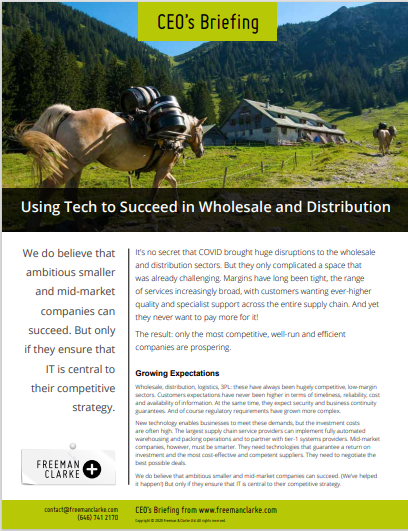Using Technology to Succeed in Wholesale and Distribution
It’s no secret that COVID brought huge disruptions to the wholesale and distribution sectors. But they only complicated a space that was already challenging.

CEO’s Briefing: Using Technology to Succeed in Wholesale and Distribution
Only the most competitive, well-run and efficient companies are prospering. Read this document to know more...
Download now for FREE!Margins have long been tight, the range of services increasingly broad, with customers wanting ever-higher quality and specialist support across the entire supply chain. And yet they never want to pay more for it!
Growing Expectations
Wholesale, distribution, logistics, 3PL: these have always been hugely competitive, low-margin sectors. Customers expectations have never been higher in terms of timeliness, reliability, cost and availability of information. At the same time, they expect security and business continuity guarantees. And of course regulatory requirements have grown more complex.
New technology enables businesses to meet these demands, but the investment costs are often high. The largest supply chain service providers can implement fully automated warehousing and packing operations and to partner with tier-1 systems providers. Mid-market companies, however, must be smarter. They need technologies that guarantee a return on investment and the most cost-effective and competent suppliers. They need to negotiate the best possible deals.
We do believe that ambitious smaller and mid-market companies can succeed. (We’ve helped it happen!) But only if they ensure that IT is central to their competitive strategy.
Start by Getting the IT Basics Right
As a CEO, your first priority is getting the basics in hand. If the IT agenda is submerged in dayto-day issues, then there is little time to talk about an ambitious vision! So what do we mean by “the basics?”
Leadership. IT needs a senior leader with both business and technical experience: someone who can set strategy, take part in business decision-making, and maintain a coherent vision for the future.
Systems and integration. Non-technical CEOs can get a handle on their systems and integration by asking a few direct questions:
• Is your IT infrastructure working reliably?
• Is the configuration sensible and appropriate?
• Do you have suitable suppliers?
• Have you negotiated the right deals and service levels?
• From top to bottom, is connectivity secure and reliable?
• Has your own staff been thoroughly trained?
Note that many of these basic questions involve suppliers. Mid-tier 3PLs, for example, typically use transport management, warehouse management and contract packing systems. Such products can be effective, though the quality of support varies. As does the quality of customization: such products may struggle to provide bespoke services, which can seriously hamper innovation for your company.
Where there are multiple systems, the challenge is even greater to integrate effectively with minimal manual effort or rekeying, and to ensure data is available for dashboards so managers can run the business hour by hour.
Reporting and data. Think of it as the goal of good integration: accurate weekly and monthly reporting so that Directors understand what’s going on, and, as above, managers are empowered to make reasonable decisions without a CEO’s day-to-day input. Similarly, data must be available from back-office systems to support website, portals, and third-party projects.
Hardware. IT infrastructure of course includes networks, servers and computers. It also includes phones and other mobile devices crucial to wholesale and distribution as cameras, in-vehicle devices and factory-floor devices. Are all these devices working together smoothly? Has your staff been trained in their use? Is it easy to collect and organize data from these devices?
Staff. It’s the common thread through all IT issues: changes and improvements will be meaningless if your people can’t master them. So don’t move forward on anything until your Board agrees on policies and standards.
Make sure that staff is both familiar with these standards and thoroughly trained in systems and devices. Monitor the efficiency of their IT use to ensure that you get the most out of your IT investment, and so that managers can quickly identify and eliminate problems (One major part of getting your IT in order is fixing problems before customers bring them to your attention). Finally, have skilled technical staff available, so data can be fed in and out seamlessly and small projects can be delivered quickly without a fuss.
Visit our Business Growth Knowledge Center